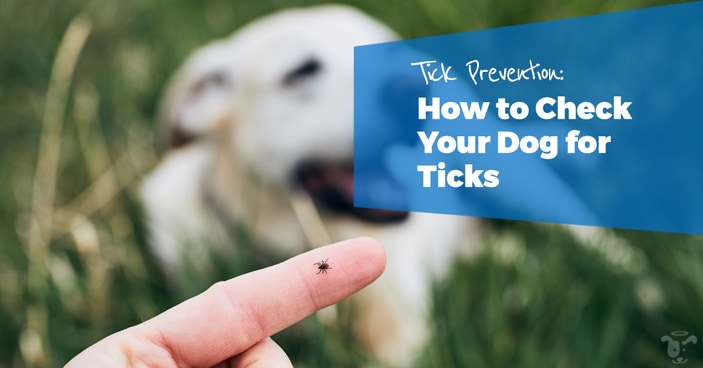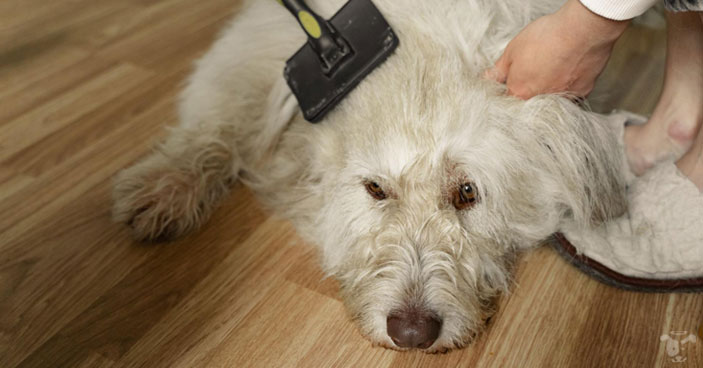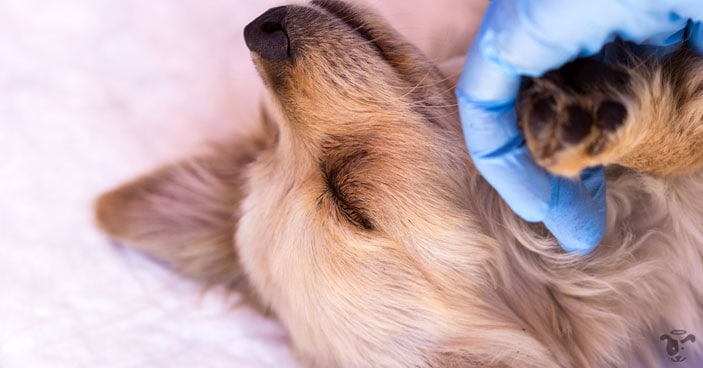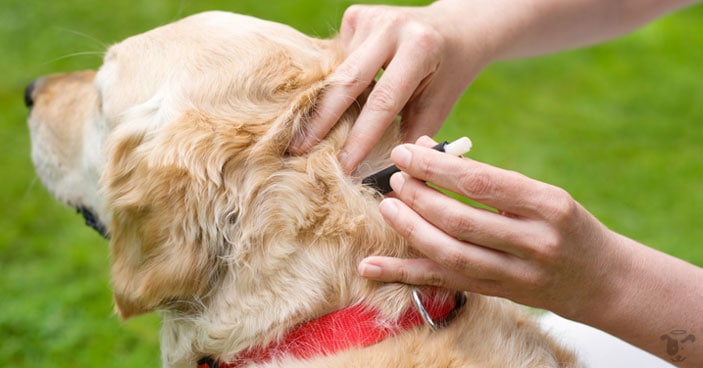
Playing outside is great for your pup. They get some fresh air and exercise to work off any excess energy from being stuck inside during the cold winter months.
While playing outside and running free is for your dog, there are dangers lurking and, although they might be tiny, pose a significant risk for your dog (and you and your family too).
That’s right, I’m talking ticks.
Ticks can carry many fatal diseases that can transfer to humans, most notably Lyme disease, which is why tick prevention is key to ensuring that your pooch stays healthy as they’re getting all that valuable outdoor time.
And keeping your pup tick-free means that you need to take special precautions every time you go outside…
…from knowing how to check them properly when they’re done playing…
…to keeping their outdoor environment safe for them to play freely…
…to responding properly when you do find a tick has latched on to your dog.
That’s why I’m happy to help you home in on all the information you need to know about ticks.
Starting with the time of year…
Peak tick season is during the warm months of the year. If you live in a climate that remains warm all year long, then tick season lasts the entire year. For others it begins in springtime (anywhere from March to May) and lasts until fall (August – November).
Coincidentally, this is also the time of year when your dog spends the most time outside.
This is why you need to be extra diligent in checking for ticks every time your pup steps outside.
Ticks can be lurking anywhere in grassy or wooded areas, and they’re about the size of a sesame seed so it’s very easy to miss them.
I’m happy to share what to look for, how to check your dog for ticks and what to do if you find one on your pup.
Checking Your Dog For Ticks

Spotting a tiny tick on your dog can be a challenge, especially if your dog has a long or dark colored coat.
Ensuring your dog is properly groomed and brushed regularly can help make looking for ticks so much easier (and can help keep your dog comfortable during the hot summer months –
check out my blog on hot weather grooming for more info).
During the spring, summer, and fall months you’ll want to check your dog for ticks every time you venture outside. Because ticks live in grass, they can easily attach to your pup if they’re walking on or near grass or trees.
To check your dog…
Start at the head, and gently rub your hands over your dog’s body, pulling back the hair or fur like a brush would.
Ticks are drawn to warm areas, so you’ll want to be sure to check the hidden areas of your dog's body.
Some of the most common hiding places for ticks are under the collar, in or behind the ears, under the tail or between the toes.
Once a tick attaches to your dog’s body, they feed on the blood and continue to grow larger. If your dog does have a tick, you will be able to feel a bump with your fingers.
Make sure you’re also looking for redness or irritation on your dog’s skin because that could be from a tick.
Always be in tune with your dog’s behavior. If they’re scratching or licking a certain area, it could be because it’s irritated from a tick (or they could have gotten into something outside that has irritated their skin and should be tended to right away).
If you do spot a tick, you’ll want to respond quickly and efficiently to properly remove the tick before it does any harm to your dog.
How to Safely Remove a Tick From Your Dog

Once you spot a tick on your dog, you’ll want to proceed with caution. If you only remove part of the tick and leave some of it behind it could lead to complications and infections later.
Supplies you’ll need: rubber gloves and fine-tipped tweezers.
You should be wearing rubber gloves during this process so that you protect yourself from infection as well.
Pinch the area of the skin around the tick and gently, yet steadily, pull the tick away from your dog’s skin using tweezers.
Be careful so that you don’t accidentally crush the tick’s body. This can cause infection.
The tick should come out cleanly and in its entirety.
Consult your vet right away if you notice any part of the tick remaining.
Immediately clean your dog’s skin using soapy warm water. You can also apply a bit of antibiotic ointment to prevent infection.
You can’t just crush a tick. In order to kill and dispose of it, you’ll want to place it in rubbing alcohol.
If you have any difficulty or questions, take your dog to their vet so they can safely remove the tick.
It’s a little nerve wracking, but the sooner you get that tick out the sooner your dog will be back to his normal self!
Tick Prevention: How to Keep Your Dog Healthy

Prevention is your first line of defense against ticks.
And just because you’re taking preventative measures does not mean you should relax on checking your dog every time you go outside.
Checking your dog thoroughly for ticks is the best way to ensure that they’re safe and healthy.
The first thing you should always do is make sure your dog is up to date on flea and tick prevention medication. Talk to your vet about all of the options to determine which one is best for you and your pup.
You’ll also want to keep your yard as safe as possible. Clear away brush and maintain a well-cut lawn to avoid leaving tall grassy areas in your yard where ticks thrive.
If you’re going on a hike or visiting a local state park, keep a close watch on your dog. Keep them away from areas with a lot of grass or extra wooded areas. If you do visit these areas, check your dog as you leave the park to try and catch any ticks quickly.
Ticks can be very dangerous to your dog, and since they’re so small it’s easy to miss them. I hope that knowing what to look for has you feeling confident that your dog will remain happy and healthy all summer long!
Here’s to a great season of soaking up the sun ☀️

~ Doggy Dan

 Playing outside is great for your pup. They get some fresh air and exercise to work off any excess energy from being stuck inside during the cold winter months.
While playing outside and running free is for your dog, there are dangers lurking and, although they might be tiny, pose a significant risk for your dog (and you and your family too).
That’s right, I’m talking ticks.
Ticks can carry many fatal diseases that can transfer to humans, most notably Lyme disease, which is why tick prevention is key to ensuring that your pooch stays healthy as they’re getting all that valuable outdoor time.
And keeping your pup tick-free means that you need to take special precautions every time you go outside…
…from knowing how to check them properly when they’re done playing…
…to keeping their outdoor environment safe for them to play freely…
…to responding properly when you do find a tick has latched on to your dog.
That’s why I’m happy to help you home in on all the information you need to know about ticks.
Starting with the time of year…
Peak tick season is during the warm months of the year. If you live in a climate that remains warm all year long, then tick season lasts the entire year. For others it begins in springtime (anywhere from March to May) and lasts until fall (August – November).
Coincidentally, this is also the time of year when your dog spends the most time outside.
This is why you need to be extra diligent in checking for ticks every time your pup steps outside.
Ticks can be lurking anywhere in grassy or wooded areas, and they’re about the size of a sesame seed so it’s very easy to miss them.
I’m happy to share what to look for, how to check your dog for ticks and what to do if you find one on your pup.
Playing outside is great for your pup. They get some fresh air and exercise to work off any excess energy from being stuck inside during the cold winter months.
While playing outside and running free is for your dog, there are dangers lurking and, although they might be tiny, pose a significant risk for your dog (and you and your family too).
That’s right, I’m talking ticks.
Ticks can carry many fatal diseases that can transfer to humans, most notably Lyme disease, which is why tick prevention is key to ensuring that your pooch stays healthy as they’re getting all that valuable outdoor time.
And keeping your pup tick-free means that you need to take special precautions every time you go outside…
…from knowing how to check them properly when they’re done playing…
…to keeping their outdoor environment safe for them to play freely…
…to responding properly when you do find a tick has latched on to your dog.
That’s why I’m happy to help you home in on all the information you need to know about ticks.
Starting with the time of year…
Peak tick season is during the warm months of the year. If you live in a climate that remains warm all year long, then tick season lasts the entire year. For others it begins in springtime (anywhere from March to May) and lasts until fall (August – November).
Coincidentally, this is also the time of year when your dog spends the most time outside.
This is why you need to be extra diligent in checking for ticks every time your pup steps outside.
Ticks can be lurking anywhere in grassy or wooded areas, and they’re about the size of a sesame seed so it’s very easy to miss them.
I’m happy to share what to look for, how to check your dog for ticks and what to do if you find one on your pup.
 Spotting a tiny tick on your dog can be a challenge, especially if your dog has a long or dark colored coat.
Ensuring your dog is properly groomed and brushed regularly can help make looking for ticks so much easier (and can help keep your dog comfortable during the hot summer months – check out my blog on hot weather grooming for more info).
During the spring, summer, and fall months you’ll want to check your dog for ticks every time you venture outside. Because ticks live in grass, they can easily attach to your pup if they’re walking on or near grass or trees.
To check your dog…
Start at the head, and gently rub your hands over your dog’s body, pulling back the hair or fur like a brush would.
Ticks are drawn to warm areas, so you’ll want to be sure to check the hidden areas of your dog's body.
Some of the most common hiding places for ticks are under the collar, in or behind the ears, under the tail or between the toes.
Once a tick attaches to your dog’s body, they feed on the blood and continue to grow larger. If your dog does have a tick, you will be able to feel a bump with your fingers.
Make sure you’re also looking for redness or irritation on your dog’s skin because that could be from a tick.
Always be in tune with your dog’s behavior. If they’re scratching or licking a certain area, it could be because it’s irritated from a tick (or they could have gotten into something outside that has irritated their skin and should be tended to right away).
If you do spot a tick, you’ll want to respond quickly and efficiently to properly remove the tick before it does any harm to your dog.
Spotting a tiny tick on your dog can be a challenge, especially if your dog has a long or dark colored coat.
Ensuring your dog is properly groomed and brushed regularly can help make looking for ticks so much easier (and can help keep your dog comfortable during the hot summer months – check out my blog on hot weather grooming for more info).
During the spring, summer, and fall months you’ll want to check your dog for ticks every time you venture outside. Because ticks live in grass, they can easily attach to your pup if they’re walking on or near grass or trees.
To check your dog…
Start at the head, and gently rub your hands over your dog’s body, pulling back the hair or fur like a brush would.
Ticks are drawn to warm areas, so you’ll want to be sure to check the hidden areas of your dog's body.
Some of the most common hiding places for ticks are under the collar, in or behind the ears, under the tail or between the toes.
Once a tick attaches to your dog’s body, they feed on the blood and continue to grow larger. If your dog does have a tick, you will be able to feel a bump with your fingers.
Make sure you’re also looking for redness or irritation on your dog’s skin because that could be from a tick.
Always be in tune with your dog’s behavior. If they’re scratching or licking a certain area, it could be because it’s irritated from a tick (or they could have gotten into something outside that has irritated their skin and should be tended to right away).
If you do spot a tick, you’ll want to respond quickly and efficiently to properly remove the tick before it does any harm to your dog.
 Once you spot a tick on your dog, you’ll want to proceed with caution. If you only remove part of the tick and leave some of it behind it could lead to complications and infections later.
Supplies you’ll need: rubber gloves and fine-tipped tweezers.
You should be wearing rubber gloves during this process so that you protect yourself from infection as well.
Pinch the area of the skin around the tick and gently, yet steadily, pull the tick away from your dog’s skin using tweezers.
Be careful so that you don’t accidentally crush the tick’s body. This can cause infection.
The tick should come out cleanly and in its entirety. Consult your vet right away if you notice any part of the tick remaining.
Immediately clean your dog’s skin using soapy warm water. You can also apply a bit of antibiotic ointment to prevent infection.
You can’t just crush a tick. In order to kill and dispose of it, you’ll want to place it in rubbing alcohol.
If you have any difficulty or questions, take your dog to their vet so they can safely remove the tick.
It’s a little nerve wracking, but the sooner you get that tick out the sooner your dog will be back to his normal self!
Once you spot a tick on your dog, you’ll want to proceed with caution. If you only remove part of the tick and leave some of it behind it could lead to complications and infections later.
Supplies you’ll need: rubber gloves and fine-tipped tweezers.
You should be wearing rubber gloves during this process so that you protect yourself from infection as well.
Pinch the area of the skin around the tick and gently, yet steadily, pull the tick away from your dog’s skin using tweezers.
Be careful so that you don’t accidentally crush the tick’s body. This can cause infection.
The tick should come out cleanly and in its entirety. Consult your vet right away if you notice any part of the tick remaining.
Immediately clean your dog’s skin using soapy warm water. You can also apply a bit of antibiotic ointment to prevent infection.
You can’t just crush a tick. In order to kill and dispose of it, you’ll want to place it in rubbing alcohol.
If you have any difficulty or questions, take your dog to their vet so they can safely remove the tick.
It’s a little nerve wracking, but the sooner you get that tick out the sooner your dog will be back to his normal self!
 Prevention is your first line of defense against ticks.
And just because you’re taking preventative measures does not mean you should relax on checking your dog every time you go outside.
Checking your dog thoroughly for ticks is the best way to ensure that they’re safe and healthy.
The first thing you should always do is make sure your dog is up to date on flea and tick prevention medication. Talk to your vet about all of the options to determine which one is best for you and your pup.
You’ll also want to keep your yard as safe as possible. Clear away brush and maintain a well-cut lawn to avoid leaving tall grassy areas in your yard where ticks thrive.
If you’re going on a hike or visiting a local state park, keep a close watch on your dog. Keep them away from areas with a lot of grass or extra wooded areas. If you do visit these areas, check your dog as you leave the park to try and catch any ticks quickly.
Ticks can be very dangerous to your dog, and since they’re so small it’s easy to miss them. I hope that knowing what to look for has you feeling confident that your dog will remain happy and healthy all summer long!
Here’s to a great season of soaking up the sun ☀️
Prevention is your first line of defense against ticks.
And just because you’re taking preventative measures does not mean you should relax on checking your dog every time you go outside.
Checking your dog thoroughly for ticks is the best way to ensure that they’re safe and healthy.
The first thing you should always do is make sure your dog is up to date on flea and tick prevention medication. Talk to your vet about all of the options to determine which one is best for you and your pup.
You’ll also want to keep your yard as safe as possible. Clear away brush and maintain a well-cut lawn to avoid leaving tall grassy areas in your yard where ticks thrive.
If you’re going on a hike or visiting a local state park, keep a close watch on your dog. Keep them away from areas with a lot of grass or extra wooded areas. If you do visit these areas, check your dog as you leave the park to try and catch any ticks quickly.
Ticks can be very dangerous to your dog, and since they’re so small it’s easy to miss them. I hope that knowing what to look for has you feeling confident that your dog will remain happy and healthy all summer long!
Here’s to a great season of soaking up the sun ☀️








4 Responses
Thank you for the great information.
Thanks Mary, I’m glad you enjoyed my Blog! All the Best, Doggy Dan
Thank you! I’ve been worrying about the best way to protect my pup; I know it’s essential!
Hi Linda, there are so many options when it comes to tick prevention but it is important to protect our pets. I’m glad you enjoyed this Blog! All the Best, Doggy Dan